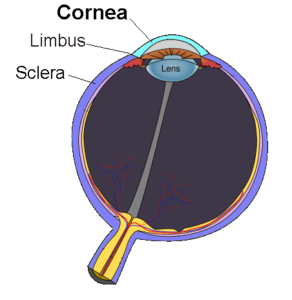Cornea
San Francisco Cornea Treatment
What is the Cornea?

The cornea is a transparent layer located in the front part of the eye. This is the eye’s outermost layer. The cornea protects your iris, pupil and the anterior chamber. Its job is to let light through the lens, similar to a window that controls the entry of light. In addition to light control, the cornea provides about 65 to 75 percent of the eye’s focusing power.
3 Main Parts
From the front to the back, these layers are the epithelium, stroma, and endothelium.
- The Epithelium: this first layer blocks dirt and foreign objects from penetrating into your eye. It also takes in oxygen and nutrients from your tears.
- The Stroma: this is the thickest part of the cornea. It’s made up mostly of water and proteins.
- The Endothelium: the third layer of the cornea and works together with the stroma, pumping out excess liquid. Without the endothelium, the stroma becomes waterlogged.
Click here to learn more about the different corneal diseases we treat.
Cornea Services Offered
A number of diseases may affect the cornea. The cornea may also be affected by infections from an injury, tissue break down, and genetic disorders. The resulting scars may damage your vision and cause blindness. Dr. Karen Oxford is our corneal and external disease specialist and surgeon. Dr. Oxford graduated Magna Cum Laude from Bryn Mawr and received high honors in Molecular Biology. With 23 years of diagnostic and surgical experience, she is truly one of the best. If you are experiencing pain, blurred vision, tearing, redness or extreme sensitivity to light you should contact us and schedule an appointment.
Cornea Conditions that we Treat:
Injury-Related Conditions
- Corneal Ulcer: Inflammation of the cornea usually due to an eye injury, trauma or other damage. Contact lens wearers are particularly susceptible to eye irritation. The contact lens may rub against the eye surface, creating slight damage to the epithelium that may enable bacteria to penetrate the eye.
- Symptoms: Itchy and watery eyes, pus-like discharge from the eye, burning or stinging sensation in the eye, pink or redness, sensitivity to light
- Corneal Abrasion/Erosion: A scratch on your cornea. This is a very common eye injury.
- Symptoms: Pain, tearing, redness, sensitivity to light, blurred vision or loss of vision, headache, a feeling that there is something in your eye.
- Pinguecula / Pterygium: A pinkish, triangular tissue growth on the cornea that appears on the white part of the eye due to ultraviolet rays from the sun. Usually a painless and slightly raised growth.
- Symptoms: Eye discomfort, growth in the eye, irritation, redness and or eye irritation.
Inflammation-Related Conditions
- Keratitis: A type of inflammation that sometimes occurs after an injury or infection. Prolonged contact lens wearing causes eye injuries which may lead to keratitis.
- Symptoms: Severe pain, blurred vision, tearing, redness, extreme sensitivity to light and discharge
- Ocular Herpes (Herpes of the Eye): This is a viral infection that may come back again and again. This condition creates sores on the cornea, but over time, the inflammation can spread deeper into your cornea and eye. This condition may often be controlled with steroid eyedrops or antiviral drugs.
- Symptoms: Redness, rash or sores on the eyelids and around the eyes, especially on the forehead, a rash on the tip of the nose, pain in and around only one eye, headache and fever.
- Herpes Zoster (Shingles): A dormant chickenpox virus that stays in your body but is not active. Later in life, the virus may travel down your body and infect specific parts of your body, like your eye. A shingles rash on the face can cause sores on your cornea. They usually heal by themselves, but antiviral medication and topical steroid eyedrops may ease inflammation.
- Symptoms: Localized burning, throbbing, stabbing pain or itchiness where the rash will soon appear. Tingling or pricking skin, followed by several days of a fluid-filled blister on red, inflamed skin, blisters crust over in a week.
Degeneration-Related Diseases
- Keratoconus: This condition occurs when your cornea thins and changes shape. As we age, the collagen in our eyes becomes weak and the collagen fibers cannot hold the cornea’s shape. This causes the cornea to change in shape and become thin. This disease may start during the teenage years and typically worsens during early adulthood. Changes to the curvature of the cornea may create mild to serious distortions. If not immediately treated, this disease can also cause swelling and scars on your cornea as well as vision loss.
- Symptoms: Blurred vision, glare, halos are night and the streaking of lights.


